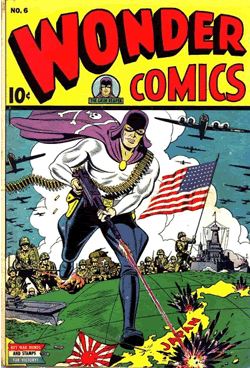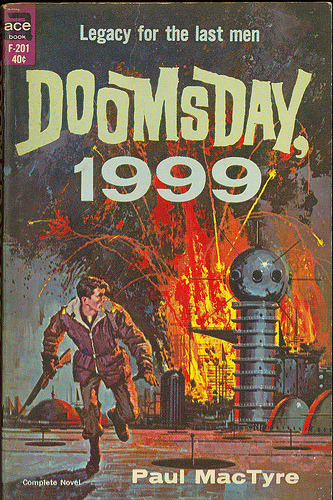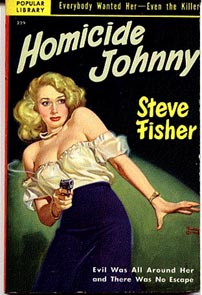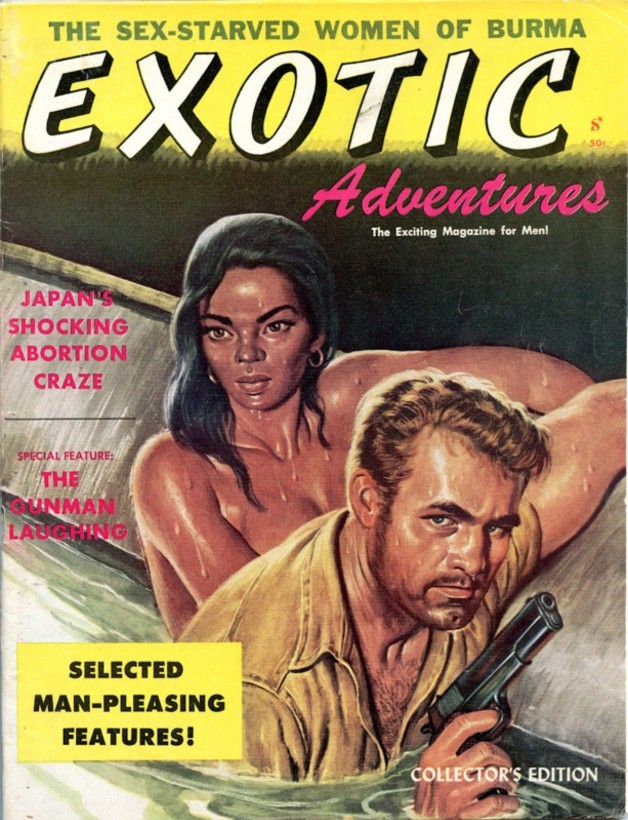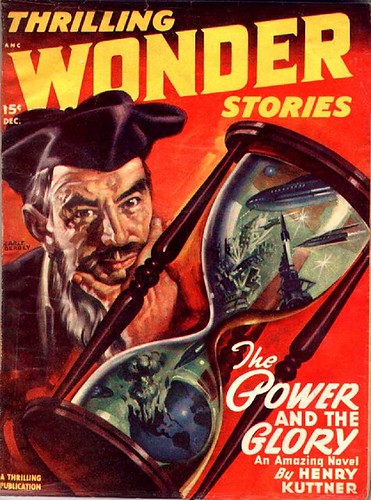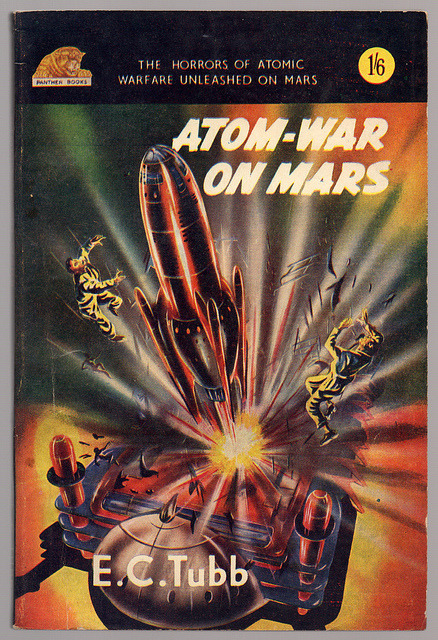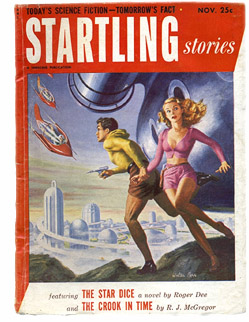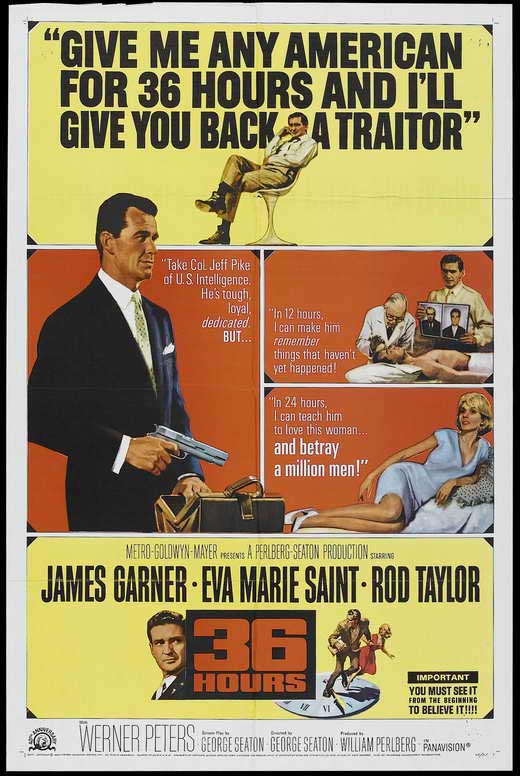 |
I don't recall exactly how I came to own a DVD of 36 HOURS (1965). I figure I got it in a trade with one of my fellow collectors at some point over the years. This is a movie that I was totally unfamiliar with but I sat down and watched it yesterday and I'm glad I did. It's a good one.
This WWII spy thriller stars James Garner as a U.S. military intelligence agent. It's days before D-Day, June 6th, 1944 and the top military brass of the Allied forces want to make the Germans believe the invasion of Europe will take place at Calais instead of Normandy. Garner is dispatched to Lisbon to distribute false information to a German agent. While in Lisbon, the bad guys slip him a mickey and he is whisked away deep behind enemy lines to Stuttgart, Germany.
A U.S. military hospital has been built in Stuttgart that is exact to the last detail. It is populated by English speaking Germans playing the parts of doctors, nurses and patients. While unconscious, Garner's hair is dyed gray, drops are put into his eyes to effect his eyesight and when he wakes up, he finds a newspaper in his room dated May, 1950.
This is all part of an elaborate plan concocted by German doctor Rod Taylor to extract valuable information from Garner concerning the upcoming invasion. If Garner can be madeto think that he's an amnesia victim and that the war has been over for six years, he might freely talk about the invasion, believing that it happened in the past instead of a few days hence. Taylor is aided by Eva Marie Saint, an English speaking German nurse who has been held prisoner in a Nazi concentration camp. Desperate to escape the prison, she agrees to go along with the scheme. Things go well for the Germans until things go wrong when Garner figures out what's really going on.
36 HOURS is a taut, WWII spy thriller that calls to mind several classic MISSION: IMPOSSIBLE episodes in which the victim of the con is made to believe that he (or she) is actually living in a different time and place. It's a fiendishly clever conceit and writer/director George Seaton (who also directed AIRPORT in 1970) handles the action admirably. The three leads are good. Garner is always a pleasure to watch, Saint is solid and Taylor (winner of the Robin Williams look-alike contest) plays a Nazi hating German doctor who cares more about advancing his medical theories for the treatment of shell shock and battle fatigue than in aiding the Third Reich. Several supporting players are better known for their roles on popular television shows of the 1960s including Alan Napier (Alfred on BATMAN), James Doohan (Scotty on STAR TREK) and John Banner (Sgt. Schultz on HOGAN'S HEROES).
The title, 36 HOURS, refers to the amount of time Taylor has to spin out his plan before Garner will be turned over to a menacing SS officer (Werner Peters) who will torture the agent for information.
36 HOURS is a nifty little war film that puts the emphasis on a psychological gambit rather than combat and battle action. Recommended.
|
Friday, November 30, 2012
36 HOURS
Monday, November 26, 2012
JACK KIRBY ART OF THE DAY
 |
Simply magnificent two-page-spread by the team supreme of Joe Simon and Jack Kirby from a Golden Age issue of CAPTAIN AMERICA COMICS. |
VINTAGE PAPERBACK COVER OF THE DAY
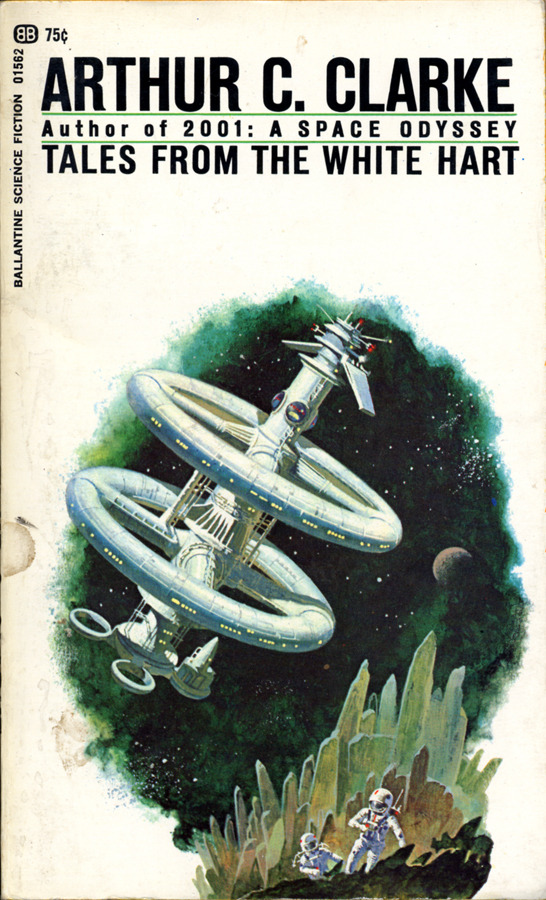 |
After seeing 2001: A SPACE ODYSSEY in the summer of 1968, I became a huge fan of British science fiction author Arthur C. Clarke. I remember buying the book featured above when I was in the seventh grade at O.Henry Junior High. I did a book report on it for my reading class taught by Mrs. Berry. As I recall, there were some pretty good short stories in this book.
|
MEN'S ADVENTURE MAGAZINE COVER OF THE DAY
 |
Terrific artwork by the great Basil Gogos who painted so many memorable covers for FAMOUS MONSTERS. |
Thursday, November 22, 2012
THE KARATE KILLERS
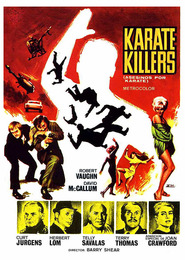 |
Solo: "Do you mind if we look around? We've never been in a real Geisha house." Kuryakin: "Speak for yourself."
I watched THE KARATE KILLERS yesterday, yet another MAN FROM U.N.C.L.E. "movie". This one is really the two-part "The Five Daughters Affair" from the show's third season.
A scientist has come up with a formula for extracting gold from sea water. THRUSH agent Herbert Lom wants it. He kills the scientist and his widow (Joan Crawford in a scene that was probably shot in an hour or less) looking for the formula. Turns out pieces of the formula are in the possession of the scientist's five daughters who are scattered across the globe. Solo and Kuryakin, along with one of the daughters, Sandy (Kim Darby), take off to find the other daughters and the missing information. They're trailed by Lom and his army of assassins, the titular "karate killers".
Along the way, they meet Telly Savalas and Curt Jurgens (two actors who would eventually play villains in James Bond films), British comic actor Terry-Thomas and the lovely Jill Ireland (who was at the time, Mrs. David McCallum before she became Mrs. Charles Bronson). The first part is episodic and lightly played. Once the pieces have been assembled, the clues point to Japan, where everyone heads next. The climax takes place in a THRUSH outpost above the Arctic Circle where Solo and Kuryakin save the day and Lom is covered in gold.
THE KARATE KILLERS isn't bad. There's a great opening sequence involving one-man helicopters attacking Solo and Kuryakin in their sleek, gull wing sports car. The women are fetching (of course) and the action fairly well-orchestrated. It's not the worst MAN FROM U.N.C.L.E. movie but it's no better than average, routine fare. I enjoyed it but I can only recommend it to die-hard U.N.C.L.E. fans.
|
JEALOUS WOMAN
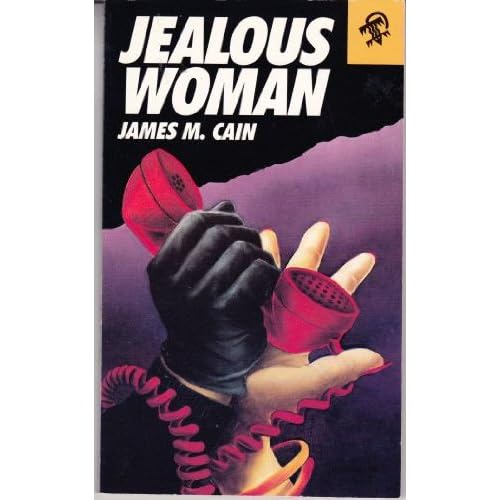 |
I finished reading JEALOUS WOMAN by James M. Cain yesterday. As much as I liked Cain's THE COCKTAIL WAITRESS, I really didn't care for this slight, forgettable mystery novel.
First published in 1950, JEALOUS WOMAN isn't a noir thriller with a doomed protagonist. It's a real mystery novel set in Reno, Nevada involving two insurance agents, two attractive women and two dead men. The most remarkable thing about this story is the appearance of ace insurance investigator Keyes, who played a part in Cain's DOUBLE INDEMNITY. This is a short book (more novella or novelette in length) and it's full of the clumsy dialogue that seems to plague Cain's work. I'm sorry but people just don't talk this way, even in 1950. The mystery is finally solved, the identity of the real killer revealed and there's a happy ending for two of the main characters.
This is far from Cain's best work and is recommended only to absolutely die-hard fans who want to read everything he wrote. It's not bad, just terribly routine and average. I expected and wanted more.
|
Wednesday, November 21, 2012
THE RED MENACE
![[theshadow_07_theredmenace_steranko.jpg]](https://blogger.googleusercontent.com/img/b/R29vZ2xl/AVvXsEimtSTe2kFnP4m4NdGb-T8X9FDwQD1D-49BRvbnbkwbMPq04DiVj4U6PXh7KZgvAgSsL692wLEc2GL_jNys-LtrSiU-VdkSlbDqlwvM3w0hFHaP9rdaxySf0iNvFHatNGyZE3QRcUun9sen/s320/theshadow_07_theredmenace_steranko.jpg) |
I finished reading THE RED MENACE by Maxwell Grant (Walter Gibson) last night. This Shadow pulp novel was originally published in November 1931 and was the fourth Shadow adventure published. The edition I read (shown above) is a Pyramid paperback published in 1975 (when I was a freshman in college). It features a terrific cover by Jim Steranko.
The story finds the Shadow squaring off against a masked villain named The Red Envoy. The Envoy is the leader of a gang of Russian spies who are out to steal the plans for a new weapon (aerial torpedoes) being developed for the U.S. government. The action ranges from the deadly streets of New York where the gang holds secret meetings to the aptly named Death Island, an isolated and menacing hunk of rock in the middle of a Connecticut lake. The finale takes place aboard a train bound for Berlin.
There's action and death traps aplenty and it's nice to see The Shadow leave the confines of New York to battle crime. Too many of his other adventures take place entirely within the city which can get a little old. Doc Savage, my favorite pulp hero, had a nice balance in his stories with the action often beginning in New York and then moving to some other (often exotic) location. Plus, it's nice to see the Shadow fight something other than organized crime (which he often battles). The Russian spy ring and the mysterious crimson-masked Red Envoy are more colorful and interesting than the run-of-the-mill gangsters.
I've read several Shadow novels over the last few years and I do enjoy them. However, I do have a few quibbles. The emphasis in these early stories is on New York based adventures and gangsters. The Shadow's agents, especially Harry Vincent, do most of the work, with the Shadow appearing intermittently in his own adventures. And almost nothing is known about the Shadow at this point in his career. We don't know who he really is nor why he wages his war on crime. I trust that as the series progressed, the Shadow mythos became more fully developed, the locales more varied and the villains more flamboyant and over-the-top. Of the pulp hero series that I've read, I'd rate Doc Savage first, The Spider second and The Shadow third.
Another thing I've noticed is that Gibson often uses the terms "revolver" and "automatic" to describe the same pistol. A revolver is vastly different from an automatic. I don't believe that this was ignorance on the part of Mr. Gibson. I think it's a result of having to crank out an entire, original novel from scratch every month for years and years. There was probably not much time for careful copy-editing and rewriting.
I enjoyed this one and look forward to reading more adventures of The Shadow.
|
Tuesday, November 20, 2012
THE COCKTAIL WAITRESS
 |
I finished reading THE COCKTAIL WAITRESS by James M. Cain yesterday. Cain, for those of you came in late, is one third of the holy trinity of American hard boiled crime writers comprised of himself, Dashiell Hammett and Raymond Chandler. I'll leave it up to you to determine which author represents the Father, Son and Holy Ghost. These three men plied their trade in the pages of the pulp magazines of the 1930s and '40s. They wrote some of the best crime stories of the twentieth century and many of their works have been made into classic films.
Cain had his own holy trinity of pulp fiction with THE POSTMAN ALWAYS RINGS TWICE, DOUBLE INDEMNITY and MILDRED PIERCE. All three are terrific novels and all three have been made into great films (some, more than once and in those cases, it is forever and always the original first versions which remain the best, most definitive adaptations of the source material).
Cain died in 1977 right about the time his body of work was beginning to achieve mainstream recognition and respect. Academics turned their attention to his novels and Cain achieved a measure of immortality as a purveyor of a unique brand of American literature. The majority of Cain's work, despite having roots firmly planted in the trashy soil of the pulp garden, transcended those humble beginnings and is still in print today.
Recently, a "lost" unpublished last novel of Cain's was discovered. The trouble was, this heretofore unknown novel, THE COCKTAIL WAITRESS, didn't exist in just one final form. There were multiple drafts of the work which included different sequences of events, changed names, different descriptions of key scenes, some extraneous material that didn't advance the plot, etc. It fell to editor Charles Ardai (the mastermind behind the extraordinary Hard Case Crime imprint) to shape all of this material into a readable, coherent, linear story. He explains his process in an afterword in the book and I'm here to say that Ardai performed an admirable job. When I was reading the story, I thought it flowed seamlessly. Well done Mr. Ardai. I think James M. Cain would be proud.
The story is narrated by the twenty-one-year old, recently widowed Joan Medford. The action opens at her husband's funeral. His death, she tells us, was an accident and besides, he was a louse who mistreated her and their son and deserved what he got when his car ran off the road and smashed into a culvert.
Joan is left penniless and unable to take care of her son, who goes to live with his aunt, Joan's sister-in-law, who wants to have Joan found unfit so she can keep the child for herself. Joan gets a tip from a sympathetic police officer and soon finds herself hired as a cocktail waitress in a local bar (this despite no previous experience). Joan, it is noted, has a great pair of legs and a body to go with them.
While working in the bar, she meets and serves a regular customer, an older, wealthy man named Earl K. White. Earl falls hard for Joan and she sees a way out of her predicament if she marries the rich old man. But she's also become involved with Tom, a handsome young man who has grandiose dreams of making it big and is also warm for Joan's form.
Through a series of classic Cain plot twists and turns, Joan marries Earl, then loses him when he dies under suspicious circumstances. The police are closing in and she soon finds herself under arrest for the murder of her younger lover, Tom.
However, charges are dropped when an inquest finds "insufficient evidence" against the young woman. She's free to start her life over but is she really? Here's where the brilliance of Cain comes into play. Everything we're told in this story is related to us by Joan who steadfastly maintains her innocence in the deaths of all three men (two husbands, one lover). The question is, is she a reliable narrator, someone that the reader trusts to be telling the truth? Or is she really a scheming murderess who has told her version of the story to cover up and omit certain facts and details and make herself look sympathetic and an innocent victim of misunderstandings and cruel fate? Cain leaves it up to the reader to decide the veracity of Joan's tale. Did she or didn't she?
THE COCKTAIL WAITRESS is a vintage slice of noir pie in which characters get helplessly entwined in webs of their own spinning (to mix metaphors). It's a fast read and I enjoyed the book with one minor quibble.
Cain excelled at plotting and characterization. What he wasn't so good at was dialogue. There are passages in the book that just don't sound right. Words are strung together in ways that no one would ever actually give voice to. The odd language and sentence structure is consistent throughout the book and it's slightly off putting. Also, the text could have used one more pass under the eye of a good copy editor as there are several mistakes of spelling, punctuation and grammar.
Still, a new James M. Cain novel is cause for celebration among genre aficionados. Even if we had to wait thirty-five years, THE COCKTAIL WAITRESS proves that the old master still had it. Highly recommended.
|
Saturday, November 17, 2012
THE SPY IN THE GREEN HAT
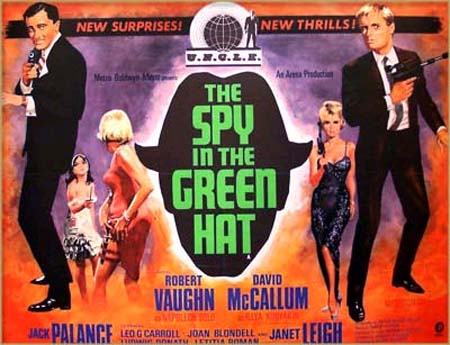 |
| "Look out! It's a pineapple!"
I watched another MAN FROM U.N.C.L.E. "movie" yesterday, THE SPY IN THE GREEN HAT. This was a theatrical release of the two-part, third season episode THE CONCRETE OVERCOAT AFFAIR.
First things first. Is there a spy in a green hat? Yes, although he doesn't appear until late in the film, so at least the title is accurate.
The plot concerns a plan by THRUSH agent Jack Palance to divert the Gulf Stream in the Atlantic Ocean and turn Greenland from an icy wasteland into a lush, tropical "Thrush" land while causing the major cities of the U.S. eastern seaboard to experience flooding and intense snowstorms. Global warming, anyone? He plans to do this by launching missiles from an island in the Caribbean. Don't ask. Palance is aided by Janet Leigh who plays a THRUSH assassin who really enjoys her work. Leigh derives almost orgasmic pleasure from killing. Pretty kinky stuff for a network television series.
Or at least, it would be, if any of this material was played remotely straight. By the time the third season of U.N.C.L.E. hit the airwaves in September 1966, BATMAN had already become a ratings sensation on rival network ABC. The producers of U.N.C.L.E. decided that "camp" was in and the direction of the MAN FROM U.N.C.L.E. took a disastrous turn in that direction, a change that ultimately doomed the series to cancellation.
Along with Palance's plot, Solo and Kuryakin get involved with a family of ancient Sicilian gangsters, the Stiletto brothers. The mobsters are after Solo to make sure he marries their niece (even at gunpoint). The gangsters are broadly played and provide no real threat. They eventually aid Solo and Kuryakin during the climactic raid on the THRUSH island fortress.
Adding immensely to the BATMAN-esque material is the musical score by Nelson Riddle, who scored the BATMAN series. I swear I heard several musical cues that were lifted directly and entirely from BATMAN. It's jinky, strained, faux-heroic fanfares, not the usual "cool" motifs provided by composers Jerry Goldsmith and Gerald Fried.
Palance (never a subtle actor), devours every piece of scenery in sight with an over-the-top, weirdly mannered performance that has to be seen to be believed. Janet Leigh, while still attractive, is a bit old for her role and is definitely slumming. By the way, I met Janet Leigh at a monster movie convention held outside of Washington, D.C. back in 2000. Leigh had just written and published a book about her experiences making PSYCHO. I purchased a copy, got her to sign it for me and she graciously posed for a picture. She was a tiny, lovely lady and I was thrilled to meet her.
THE SPY IN THE GREEN HAT is far from U.N.C.L.E.s finest hour. It's corny, silly and slightly embarrassing and as such, is recommended for die-hard fans only.
|
PASSPORT TO PERIL
 |
I finished reading PASSPORT TO PERIL by Robert B. Parker yesterday evening. This 1951 Cold War spy thriller is a bit of a departure from the usual crime noir material released under the Hard Case Crime imprint but it's a fast paced thriller with plenty of twists and turns.
The author is the original Robert B. Parker, a WWII foreign correspondent who is not to be confused with the late Robert B. Parker who wrote the Spenser series of private detective novels.
In PASSPORT, an American journalist travels behind the Iron Curtain to learn what happened to his brother, an Army Air Force pilot who was shot down during WWII. Our hero, John Stodder, is traveling on the famed Orient Express with a fake passport. He encounters Maria, a beautiful young woman who is on the run from the man who murdered her employer. Turns out that the passport Stoddard thinks is fake is real and belonged to the murdered man. Before you know it, he and Maria are jumping off of the train in the middle of the night and plunging into an adventure involving a die hard Nazi, a deadly femme fatale, Russian officers, unlikely American spies and a must-have envelope containing information about various scientists who worked for the Germans in WWII.
PASSPORT TO PERIL is a brisk spy thriller that is a true product of it's time and place. Parker covered Eastern Europe before, during and after the war and he had first hand knowledge of the the politics, cultures, cities and ways of life he writes about. Great literature? No, but it's a solid piece of intrigue and espionage. Give it a read and see if you don't agree.
|
Friday, November 16, 2012
DINER
 |
| "Does that include the Maryland fried chicken dinner?"
Judy and I watched DINER (1982) the other night. It was the first time she'd seen it. I've lost count of how many times I've seen this film but I hadn't seen it in several years and it was a nice visit with an old friend.
Barry Levinson's semi-autobiographical film recounts a group of young men in Baltimore, 1959. The men are a close knit group. They've grown up together but now, in their early twenties, they're all struggling with different aspects of maturity, responsibility and becoming "adults". They want desperately to hold onto the past while simultaneously taking steps into the unknown future in which each must stand on his own in either success or failure.
The group includes Eddie (Steve Guttenberg), a spoiled mama's boy who still lives at home although he's engaged to be married to a never fully seen woman named Elyse. The marriage hinges upon whether or not Elyse can pass a brutal test of Baltimore Colts football trivia. She fails the test but Eddie goes ahead with the wedding ceremony anyway.
Shrevie (Daniel Stern), is the one married man in the group. His wife (Ellen Barkin), doesn't understand the connection Shrevie has with his buddies. Shrevie, an obsessive-compulsive record collector and music fan, works in an appliance store and seems happiest when he's talking music with the diner guys.
Boogie (Mickey Rourke) is a smooth-talking ladies man who works in a beauty parlor by day and attends law school classes at night. He's also a man with a gambling addiction who finds himself in over his head with debts he cannot pay. He's eventually taken under the wing of Bagel (Michael Tucker), an older diner regular, who pays off Boogie's debts in return for work from the young man.
Fenwick (Kevin Bacon) is an underachieving guy with a drinking problem. Although not formally educated, Fen has more innate knowledge about "stuff" than his peers but he has no drive to apply this knowledge to anything productive and instead lives off of trust-fund money.
Tim Daly is Billy, the only member of the group to leave town for college. He returns for Eddie's wedding and discovers that his platonic girlfriend is now pregnant, the result of a one-night stand in New York. Billy is an earnest young man who is determined to do the right thing.
Modell (Paul Reiser) is the least developed character but he does have several very funny lines ("You know what word I'm not comfortable with? Nuance.").
The final major player in the film is the Fells Point Diner where the guys hang out for late night bull sessions. They smoke, consume plates of french fires with gravy (with a cherry Coke) and relive their glory days. Much of this dialogue was improvised by the actors who spent a lot of time hanging out together and getting to know each other before the cameras ever started rolling.
DINER is a warm, funny, heartfelt coming-of-age film that never becomes overly sentimental. The film has a terrific soundtrack of period rock and r&b songs and the art direction is first rate. The clothes, cars and settings are all authentic and I'd forgotten just how good the film looks.
When Judy and I visited Baltimore last year, I was determined to eat at the Fells Point Diner. The concierge at our hotel swore it was a great place to eat and we hailed a cab and headed off for breakfast one morning. When we arrived at the location (not on the waterfront as in the film but in a dense, urban neighborhood), the diner was long closed and out of business. Someone needs to update their website.
There's a scene in the film in which Boogie is confronted by Tank, a gambling enforcer, outside of the beauty parlor where Boogie works. When I saw the scene this time, I immediately recognized it as a street that Judy and I had walked along near the Walters Art Museum (which was really interesting). Of course, I didn't recognize the street when we were there but I instantly knew it when I saw the film.
DINER had a huge influence on me and my buddies. We saw the film many times over the years and would regularly quote dialogue from the movie. We saw parts of ourselves reflected in the characters and their situations although we did not grow up in Baltimore in 1959. That doesn't matter. What the men in DINER experience is universal.
How big an influence was DINER? Well, when Judy and I were planning our wedding we had a great meeting with our photographer Mark Gaynor. He empathized that he loved to do creative, original, imaginative work, not the standard posed wedding stuff. We were his customers and he would take any pictures we wanted. I asked for two things from him and he delivered.
First, I asked that he photograph all of the groomsmen, ushers and myself in front of Dirty Martin's hamburger joint on the Drag. If any local restaurant would qualify as our "diner" it would be Dirty's. We've been regularly eating there since we were at Austin High in the '70s. Mission accomplished.
Second, I asked if he would do the "DINER shot" (see image above) of the men around the table staring into the camera with blank expressions. He did so and we have that picture (along with others from the wedding) framed and on display in our home. The shot includes myself along with my best pals: the late Ray Kohler, Steve Cook, Terry Porter and Robert "Smiley" Morgan.
How many other people have asked for that iconic image to be recreated as part of the most memorable day of their life? I don't know if there's anyone else out there who had this idea but I do know one thing.
The guys at the diner would be proud.
|
Thursday, November 15, 2012
JACK KIRBY ART OF THE DAY
 |
Here's the Mighty Thor comin' at ya courtesy of Stan Lee, Jack Kirby and Vince Colletta.
In my estimation, Kirby's all-time best and greatest inker was Joe Sinnott. Colletta, on the other hand, didn't always ink everything that Jack drew and sometimes omitted figures, buildings and other background objects. Vince wasn't the best inker in the business but he was apparently one of the fastest and thus, got a lot of assignments on work that had an incredibly short deadline. He inked tons of comic book pages over the course of his life and while he was never my favorite, I must admit that his work seemed perfectly suited to Kirby's pencils on THOR. Not on any other Kirby illustrated title, just THOR. Somehow, for me, that combination worked.
|
VINTAGE MOVIE POSTER OF THE DAY
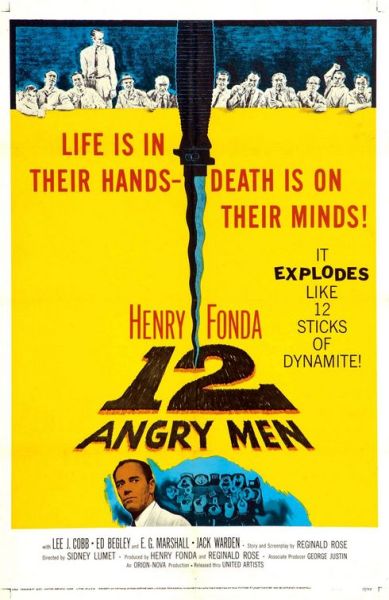 |
Back in the late '80s-early '90s I worked at a video rental store. One day, a customer came in and asked, "do you have twelve angry men?"
"No," I replied. "But we've got a couple of pissed off guys in the back."
|
Wednesday, November 14, 2012
THE CAMP ON BLOOD ISLAND
Monday, November 12, 2012
GOLDEN AGE COMIC BOOK COVER OF THE DAY
 |
One of the most iconic covers of the Golden Age. Truth, Justice and the American Way. Amen. |
SILVER AGE COMIC BOOK OF THE DAY
 |
In the spring of 1968 (I was in the sixth-grade at Brykerwoods Elementary School), the powers-that-be at Marvel Comics made the decision to give the popular supporting character The Silver Surfer his own title. The Surfer had previously appeared in the pages of THE FANTASTIC FOUR where his appearances were written and drawn by Stan Lee and Jack Kirby.
For the Surfer's own book, the creative team was Stan Lee and John Buscema and, in my opinion, they did stellar work for the first ten issues or so. In addition to a great character and top-notch creative team, THE SILVER SURFER was a giant-size comic book with a cover price of twenty-five cents. It cost more than the regular twelve-cent Marvel Comic but that was one quarter that was well-spent as the additional page count allowed Lee and Buscema to really let lose with their stories.
The giant-size format lasted only seven issues before THE SILVER SURFER reverted to a regular size comic book with a cover price of fifteen cents. The title was cancelled after eighteen issues and oddly enough, number eighteen was the only issue in the series to be written and drawn by the Surfer's co-creators Stan Lee and Jack Kirby.
All of this material has been collected and reprinted, both in color and in black-and-white. I have a copy of the MARVEL ESSENTIAL SILVER SURFER b&w reprint volume (which collects the entire eighteen issue run) on my shelf. But I also have this material in a unique, one-of-a-kind collector's item.
Years ago, my buddy Bob Parker had all eighteen issues of THE SILVER SURFER professionally bound into one hardcover volume. I am now the proud owner of said volume as Bob traded it to me several years ago. It's a unique way to enjoy this unique comic.
|
THAT'S IMMORALITY...
 |
I'll confess. The first time I saw this book I read the title as The Immortality Engine, as in some infernal device that provides eternal life. Upon closer inspection, I had a "D'oh!" moment as I realized the title was The Immorality Engine. And yes indeed, there is one such device within the pages of this cracking good steam punk novel.
The Immorality Engine, by British science fiction author George Mann, is the third volume in his series featuring Victorian era secret agents Sir Maurice Newbury and Veronica Hobbes (the other novels are The Affinity Bridge and The Osiris Ritual). It helps to picture John Steed and Emma Peel from television's THE AVENGERS, in an early 1900s London in which steam driven technology (along with a dash of the occult), is commonplace. The two are agents of Queen Victoria (who figures prominently in this novel). But this is not the Queen Victoria of our world and history. This is a decrepit, near-dead monarch kept alive by bizarre steam punk life support mechanisms. She should be dead but she isn't. Instead, the Empress spins a deadly web of deceit, lies and betrayal all in the name of retaining her death-grip upon the throne of England.
The action opens with the funeral of Amelia, Veronica's invalid, psychic sister but we soon learn that, as in all good thrillers, not all is as it seems. Sir Maurice has become more dependent than ever before upon opium and it's up to Veronica and Sir Charles Bainbridge of Scotland Yard to rescue their friend from the clutches of addiction. There's a mystery afoot that will require all three agents to be at the top of their game.
The mystery involves two identical dead bodies of a notorious thief (who uses a small, deadly, mechanized spider to commit his crimes). Yes, clones are alive and well in London along with the sinister and secret Bastion Society, an organization of wealthy elites who want to both live forever and return the British Empire to a world wide power. To achieve these ends will require the use of the title mechanism along with a clutch of clones, a mechanized cavalry of steam driven horses (equipped with side mounted Gatling guns), gigantic suits of mobile armor and more.
There are death-traps, close escapes, chases, numerous battles, shocking surprises and more in these pages. I've now read all three of Mann's Newbury and Hobbes novels and I give all three of them my highest recommendation. I like the way Mann drops references to other cases and not-yet recorded adventures of Sir Maurice and Veronica throughout the narrative and the last chapter nicely sets things up for the next thrilling installment.
If you enjoy reading pulp action and adventure, you need to check out all three of these books. You won't be disappointed.
|
Friday, November 9, 2012
Thursday, November 8, 2012
DKR
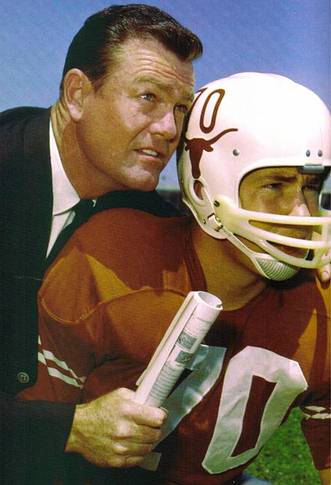 |
| When I was a kid, my buddies from the neighborhood and school would regularly gather in the front yard of my house for a game of touch football. Understand, we did this without any adult supervision whatsoever. We had no protective gear, no referees, no coaches. It was just choose up sides and play. As we played, neighbors would drive by in their cars, honk and wave. I knew every one that lived on my street and what car they drove. I was always happy to wave at a neighbor and have them wave back. But there was one neighbor that we waved to with a bit more enthusiasm than the rest. Sometimes that neighbor would pull his car over, roll down the car window and visit with us for a few minutes. Those were conversations that were definitely worth stopping our games for. That neighbor wasn't just any guy. He was a legend. He was Darrell Royal. I grew up on a street in West Austin that was paved, not in bricks of gold, but in bricks of burnt orange. Consider this roll call of neighbors: Rooster Andrews, a Longhorn sports legend and owner of a chain of sporting goods stores in Austin, Jack Maguire, executive director of the UT Ex-Student's association, Mike Cotton, former UT football player and, down at the end of the street towards the cul-de-sac, Coach Darrell K. Royal. I can't say that I was close friends with Coach Royal but he did know me and would call me by name whenever he stopped to chat. Can you imagine what that meant to an adolescent Longhorn football fan? No matter how busy he was or what stress he was under at the time, he always had time to share a few kind words with the neighborhood kids. My parents knew Coach Royal and his wife Edith better than I did. I've got pictures around here somewhere of my mom and dad at cocktail parties with Darrell and Edith, along with other friends and neighbors. I recall that when Coach Royal's daughter Marian died, my mother and I took some food down the street to the Royal's house and we shared a short visit with them in the midst of their grief. Once, neighborhood scuttle-butt got out that there was going to be a party at the house at the end of the street where the publisher of The Austin American-Statesman lived. Coach Royal would be in attendance of course (he didn't have far to walk!) along with the featured guest of honor, actor Fess Parker, a UT alumni who starred as both Davy Crockett and Daniel Boone on television. I remember all of us kids trying desperately to figure out a way to crash this for adults, by-invitation-only soiree. We never did, of course, but just knowing that Davy Crockett himself was at a party at the end of my street for one night made me crazy. On December 6th, 1969, undefeated Texas played undefeated Arkansas in what was dubbed "The Game of the Century". It was college football's 100th anniversary and the game between the rivals would decide which team would be crowned national champion. President Richard Nixon attended the game and planned to visit the winning team's locker-room after the game and bestow the title of national champs upon that team. Texas was behind 14-0 at the beginning of the fourth quarter when Longhorn quarterback James Street scrambled for a long touchdown run and then went for and made the two-point conversion. But it was later in the game, with Texas facing a fourth-down and three, that history was made. I was watching the game at home on television and was going nuts pulling for the 'Horns. If they didn't win this game, I would be devastated. This was the biggest college football game I'd ever seen and literally everything (in terms of college football) was at stake. Coach Royal famously said, "there are three things that happen when you throw the ball and two of them are bad." On this crucial play of plays, Royal rolled the dice and instructed Street to throw the ball rather than run it. The pass, Street to Randy Peschel (who was double covered), was more than a simple throw and catch. It was a toss into eternity, into immortality, into Longhorn legend and glory. Next to Vince Young's run to daylight against USC in the BCS Championship Game, Street to Peschel remains the greatest play in the history of Longhorn football. When the game was over and Texas had been named the National Champions, my neighbor buddy John Rideout and I grabbed a can of white spray paint and headed for the street outside of Coach Royal's house. We painted an enormous, white "#1" on the street, a numeral that lasted for quite a long time. I'm sure that this was technically an act of vandalism but we didn't know or care about that. All we knew was that our Horns were the champs and we wanted to let our neighbor and friend know how much that meant to us. Finally, I'd like to tell you that Coach Royal got some of his more innovative plays from us, the neighborhood kids running around in my front yard. I'd like to say that we gave him the fabled "wishbone" formation, but history proves me a liar on that count. However, we did have a couple of imaginative plays that Coach Royal could have used if the circumstances ever dictated. One involved sending a wide receiver completely around a neighbor's house to emerge on the far side wide open for a touchdown pass. Another required a receiver to open the unlocked door of a car parked at the curb, crawl through the car and emerge open for the pass while the defender was still climbing his way over the front seat. We actually ran these plays at least once. They worked. Hook 'em. |
Monday, November 5, 2012
DOC SAVAGE IMAGE OF THE DAY
 |
Boris Vallejo provides the cover art for THE MOUNTAIN MONSTER, Bantam paperback reprint #84. I've got this one. |
SUPERMAN IMAGE OF THE DAY
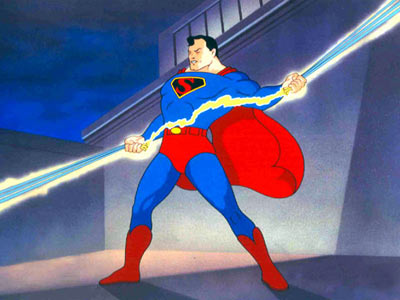 |
A cell from one of the SUPERMAN cartoons produced by Dave Fleischer at Paramount Studios in the 1940s. These are great cartoons! |
JACK KIRBY ART OF THE DAY
 |
| Here's the cover of DC's hardcover reprint volume which collects the entire run of Jack's mid-70s OMAC: One Man Army Corps series. Part science fiction, part adventure, all Kirby, OMAC, though short-lived was definitely ahead of its' time and introduced characters and concepts that are still being used by comic book creators at DC today. I have this volume in the Jack Kirby section of my library. Highly recommended. |
GOLDEN AGE COMIC BOOK COVER OF THE DAY
 |
I think this is more Silver Age than Gold but what the heck. Gorgeous wash-tone art on one of DC's second tier mystery/adventure titles. I have a few issues of MGA in my collection. They're fun books. This is the title in which The Doom Patrol premiered and that super-team took over the title's numbering soon after. |
Subscribe to:
Posts (Atom)





